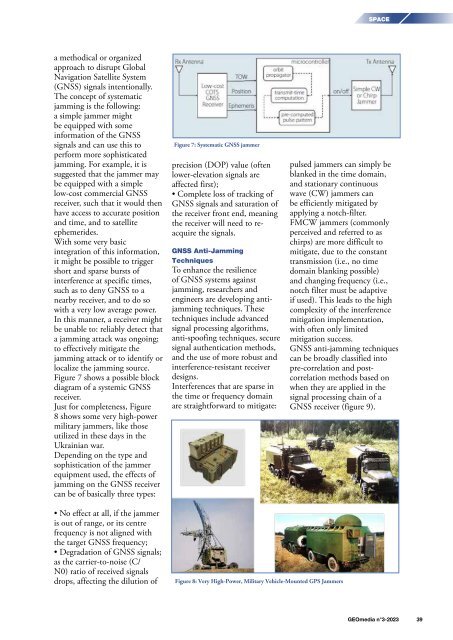GEOmedia_3_2023
EUMAP During the recent pandemic period, the world's attention has shifted towards the healthcare sector, with world leaders striving to avoid the collapse of their national healthcare systems; the economy has entered an artificial coma, while utility systems, including energy, water, telecommunications and waste management systems, have been asked to act immediately in response to these unprecedented conditions, placing extreme pressure on public utility systems.
EUMAP
During the recent pandemic period, the world's attention has shifted towards the healthcare sector, with world leaders striving to avoid the collapse of their national healthcare systems; the economy has entered an artificial coma, while utility systems, including energy, water, telecommunications and waste management systems, have been asked to act immediately in response to these unprecedented conditions, placing extreme pressure on public utility systems.
Create successful ePaper yourself
Turn your PDF publications into a flip-book with our unique Google optimized e-Paper software.
SPACE<br />
a methodical or organized<br />
approach to disrupt Global<br />
Navigation Satellite System<br />
(GNSS) signals intentionally.<br />
The concept of systematic<br />
jamming is the following:<br />
a simple jammer might<br />
be equipped with some<br />
information of the GNSS<br />
signals and can use this to<br />
perform more sophisticated<br />
jamming. For example, it is<br />
suggested that the jammer may<br />
be equipped with a simple<br />
low-cost commercial GNSS<br />
receiver, such that it would then<br />
have access to accurate position<br />
and time, and to satellite<br />
ephemerides.<br />
With some very basic<br />
integration of this information,<br />
it might be possible to trigger<br />
short and sparse bursts of<br />
interference at specific times,<br />
such as to deny GNSS to a<br />
nearby receiver, and to do so<br />
with a very low average power.<br />
In this manner, a receiver might<br />
be unable to: reliably detect that<br />
a jamming attack was ongoing;<br />
to effectively mitigate the<br />
jamming attack or to identify or<br />
localize the jamming source.<br />
Figure 7 shows a possible block<br />
diagram of a systemic GNSS<br />
receiver.<br />
Just for completeness, Figure<br />
8 shows some very high-power<br />
military jammers, like those<br />
utilized in these days in the<br />
Ukrainian war.<br />
Depending on the type and<br />
sophistication of the jammer<br />
equipment used, the effects of<br />
jamming on the GNSS receiver<br />
can be of basically three types:<br />
Figure 7: Systematic GNSS jammer<br />
precision (DOP) value (often<br />
lower-elevation signals are<br />
affected first);<br />
• Complete loss of tracking of<br />
GNSS signals and saturation of<br />
the receiver front end, meaning<br />
the receiver will need to reacquire<br />
the signals.<br />
GNSS Anti-Jamming<br />
Techniques<br />
To enhance the resilience<br />
of GNSS systems against<br />
jamming, researchers and<br />
engineers are developing antijamming<br />
techniques. These<br />
techniques include advanced<br />
signal processing algorithms,<br />
anti-spoofing techniques, secure<br />
signal authentication methods,<br />
and the use of more robust and<br />
interference-resistant receiver<br />
designs.<br />
Interferences that are sparse in<br />
the time or frequency domain<br />
are straightforward to mitigate:<br />
pulsed jammers can simply be<br />
blanked in the time domain,<br />
and stationary continuous<br />
wave (CW) jammers can<br />
be efficiently mitigated by<br />
applying a notch-filter.<br />
FMCW jammers (commonly<br />
perceived and referred to as<br />
chirps) are more difficult to<br />
mitigate, due to the constant<br />
transmission (i.e., no time<br />
domain blanking possible)<br />
and changing frequency (i.e.,<br />
notch filter must be adaptive<br />
if used). This leads to the high<br />
complexity of the interference<br />
mitigation implementation,<br />
with often only limited<br />
mitigation success.<br />
GNSS anti-jamming techniques<br />
can be broadly classified into<br />
pre-correlation and postcorrelation<br />
methods based on<br />
when they are applied in the<br />
signal processing chain of a<br />
GNSS receiver (figure 9).<br />
• No effect at all, if the jammer<br />
is out of range, or its centre<br />
frequency is not aligned with<br />
the target GNSS frequency;<br />
• Degradation of GNSS signals;<br />
as the carrier-to-noise (C/<br />
N0) ratio of received signals<br />
drops, affecting the dilution of<br />
Figure 8: Very High-Power, Military Vehicle-Mounted GPS Jammers<br />
<strong>GEOmedia</strong> n°3-<strong>2023</strong> 39

















